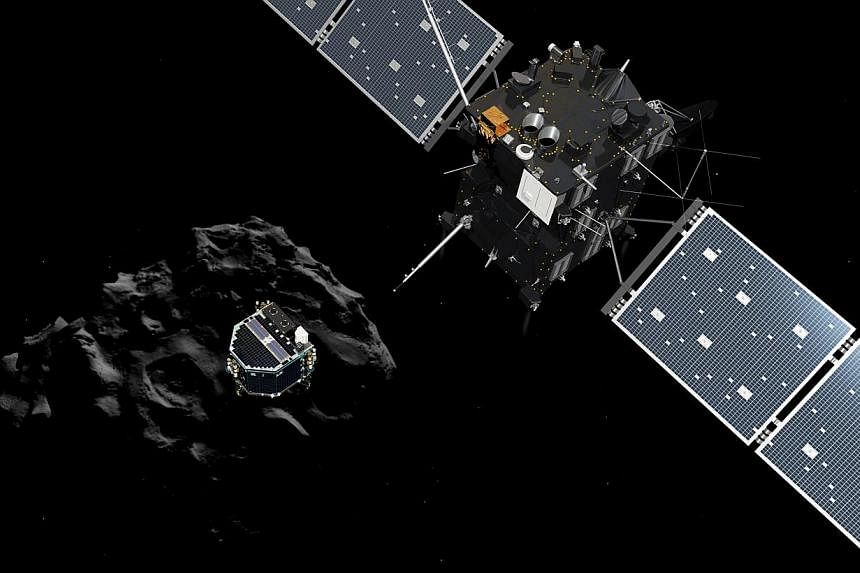PARIS (AFP) - Robot probe Philae uploaded a slew of last-minute data to Earth on Friday from a comet in deep space, before going to sleep at the end of its historic mission, ground controllers said.
Data streamed in as soon as Europe's pioneering robot lab reestablished late-night contact with its orbiting mothership, Rosetta, but its limited battery soon started wavering. "My #lifeonacomet has just begun," said an official tweet in the name of the washing machine-sized lander perched on comet 67P/Churyumov-Gerasimenko since Wednesday - concluding with a restful "zzzzz".
"S'ok Philae, I've got it from here for now. Rest well...," said a response tweeted on behalf of Rosetta.
The European Space Agency (ESA) said its robot lab had entered "idle mode", with all instruments and most systems shut down after three days of non-stop work - taking pictures and probing the comet's density, temperature, composition and atmosphere. "Prior to falling silent, the lander was able to transmit all science data gathered," said a statement.
Philae sent home data from a drill experiment, a key part of its mission, before the lander fell silent for lack of power, a scientist said on Saturday.
"We received everything," mission scientist Jean-Pierre Bibring told AFP, about the scramble to get data home before Philae went into stand-by mode.
The experiment analysed a sample drilled from the comet's surface, looking for chemical signatures that could help explain the origins of the Solar System.
The lander and its mothership, which relayed Philae's data to Earth, had only two communications windows per day - the last opened around 9.30pm GMT on Friday and closed at 12.36am GMT the next morning as Rosetta disappeared in orbit behind the comet.
Mission controllers had feared the robot may not even have enough power to make contact during this window - but they were pleasantly surprised.
"Science from an alien world," ESA Operations tweeted when contact was made.
"Info now flowing from @ Philae2014."
The channel should open again around 10am GMT on Saturday, but lander manager Stephan Ulamec told AFP from mission control in Darmstadt, Germany, he did "not really expect" contact with Philae then.
"The chances that we could reestablish the link again tomorrow are really very, very low," he said.
"The battery is not completely empty, but it is below the level the central computer needs to boot" up.
In one of many jaw-dropping achievements, the robot lab appears to have lifted itself slightly on Friday and rotate the larger of its solar panels to absorb as much energy as possible to be stored for a possible wakeup later.
Philae had landed in a dark ditch after a bouncy touchdown on Wednesday, and did not get enough sunlight to recharge its batteries sufficiently to extend its mission.
Mission engineers dream, however, of making contact with the lander "at some point" in the coming months as the comet, with Philae hopefully still clinging to its surface, moves closer to the Sun.
Philae's historic on-site survey of a comet travelling at 18km per second, currently at a distance of 510 million km from Earth, is the highlight in a more than decade-long mission.
Philae landed on Wednesday after a nail-biting seven-hour, 20km descent from Rosetta, which had travelled more than a decade and 6.5 billion km to meet up with the comet in August this year.
The touchdown did not go entirely as planned, when Philae's duo of anchoring harpoons failed to deploy and it lifted off again... twice.
The lander finally settled in a crevice in a location that remains a mystery, and data revealed it was shadowed from sunlight that could have extended its core, battery-powered mission of 60-odd hours.
Among the most anticipated data from Philae is chemical analysis of a drill sample which scientists hope will shed light on the origins of the Solar System 4.6 billion years ago, and maybe even life on Earth.
The ESA confirmed that Philae had drilled on Friday, though it did not specify whether a sample had been obtained.
"I confirm that my (drill) went all the way DOWN and UP again!!" said a tweet in the robot's name.
"First comet drilling is a fact!" The Rosetta-Philae team said on Friday they were ecstatic with the results.
"We're in the middle of drinking champagne because this mission is a success," Mr Philippe Gaudon, the head of the Rosetta project at France's space studies centre CNES, told AFP early on Saturday.
All 10 instruments on board the 100kg lab had kicked into action.
"This machine performed magnificently under tough conditions, and we can be fully proud of the incredible scientific success Philae has delivered," said Mr Ulamec.
The 1.3 billion euro (S$2.1 billion) mission aims to unlock the secrets of comets, which some astrophysicists believe may have "seeded" Earth with some of the ingredients for life.

